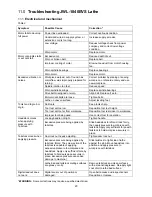
16
9.0
Operation
The information which follows is general in nature
and not intended to be a complete course in
woodturning. Nothing can replace knowledge
gained by talking to experienced woodturners or
consulting books or trade magazines. Above all,
simple trial and error will aid in developing
proficiency in the craft.
9.1
Inspection
Before operating the lathe, check that everything is
in proper working order:
1. Level your machine; use the leveling feet to
help reduce vibration.
2. Check bearings; adjust only if endplay exists.
3. Check belt; it should be snug but not overly
tight.
4. Bed ways; keep clean, use steel wool to
remove any rust spots, and apply paste wax to
prevent buildup of rust and finishes.
5. Tool rest; use a mill file to remove nicks and
dings.
6. Spindle tapers; should be clean and free of
dust and chips for proper seating of tapers.
7. Tailstock; clean and lubricate quill and locking
device.
8. Lighting; proper lighting is essential to
eliminate shadows and reduce eye strain.
9.2
Turning Tools
If possible, select only good-quality, high-speed
steel turning tools. High-speed steel tools hold an
edge and last longer than ordinary carbon steel. As
one becomes proficient in turning, a variety of
specialty tools for specific applications can be
acquired. The following tools provide the basics for
most woodturning projects (see Figure 9-1):
Skews
– 1-1/2" and 1" or 1-1/4", used to make
finishing cuts and details.
Large Roughing Gouge
– 1" to 1-1/4", used to
eliminate waste wood.
Spindle Gouges
– 1/4", 3/8", 1/2", used to turn
beads, coves and other details.
Deep Fluted Bowl Gouge
– 1/4", 3/8" and 1/2",
used for turning bowls & plates.
Square Scraper (Bedan)
– 3/8” or 1/2", used to
create square shoulders.
Large Round Nose (Domed) Scraper
– 1-1/2",
used to reduce ridges on interior of bowls, round
edges of bowls, etc.
Parting Tool
- 1/8", used for scraping, making a
cut-off, or to set diameters for sizing.
For safety and best performance,
keep tools sharp
.
If a tool stops cutting or requires excessive
pressure to make a cut, it needs to be sharpened.
A number of brand name sharpening jigs and
fixtures are available; however, a woodturner
should learn to sharpen tools freehand.
For best results, use a slow speed grinder (1800
rpm) fitted with a 60-grit aluminum oxide wheel (for
shaping) and a 100-grit alum. oxide wheel (for final
sharpening and touchup). The grinder should be
located near your lathe and at a comfortable
height. A diamond dresser will keep the wheels
true and eliminate glazing. Never allow the tool to
rest in one place on the wheel, keep it moving and
use a light touch.
Figure 9-1: basic turning tools
Carbon steel tools can overheat easily and should
be cooled frequently. If the edge turns blue, it has
lost its temper and should be ground past the blue
area. High-speed steel tools are not as likely to
overheat, but can be damaged if allowed to get red
hot. High-speed steel tools should not be
quenched for cooling. Honing with a diamond lap
or slipstone will save trips to the grinder and keep
the edge fresh.
9.3
Spindle Turning
Spindle turning takes place between the centers of
the lathe. It requires a spur or drive center in the
headstock and a live or dead center in the tailstock.
A cup center rather than a cone center in the
tailstock will often reduce the risk of splitting the
stock.







































